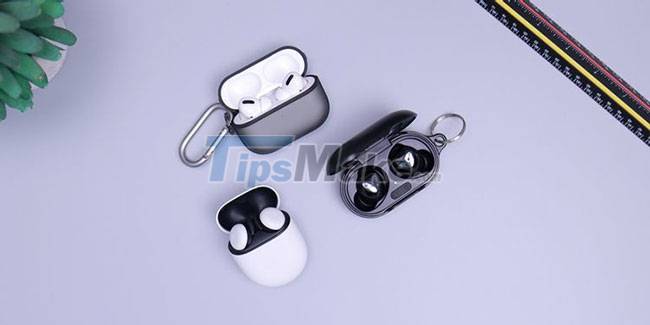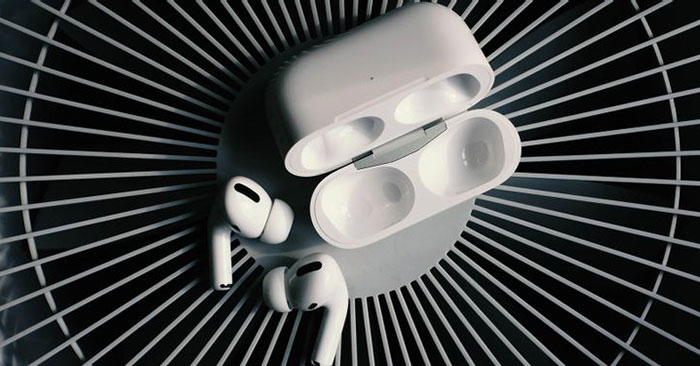The difference between Wireless and True Wireless headphones
If you're shopping for wireless headphones, you may have noticed that there are two different types. You can choose between Wireless and True Wireless headphones. So what exactly are the differences between them and which one should you buy?
What are Wireless Headphones?

Wireless headphones do not require wires to connect to an audio source. Instead, the audio is transmitted via Bluetooth. They are not called True Wireless because there is still a wire running between the two sides of the headset. Wireless headphones are available as on-ear/over-ear headphones and earbuds. You can tell the difference because the two earbuds are actually connected.
What are True Wireless Headphones?

True Wireless headphones don't have any wires. They connect to the audio source using Bluetooth (and sometimes the 2.4GHz wireless frequency), and each headset is physically independent. True Wireless headphones are only available as earbuds. Each pair of True Wireless headphones has a primary ear and a secondary ear. The main ear is connected to the sound source and sends the signal to the secondary ear.
Is there any difference in sound?
There is almost no difference in sound quality between Wireless and True Wireless headphones. But there is a difference between wired and wireless headphones. This happens because the sound is compressed before it travels from the audio source to the headphones. This happens regardless of how the actual headsets communicate with each other.
It's worth noting that wireless headphones in general are also improving. They still don't sound as good as the wired option, but the difference is so small that only audiophiles will notice.
What about battery life?
Battery life is an important factor to consider when choosing True Wireless headphones. Because there's nothing connecting the two sides of the headset, there's nowhere to put the battery except the headset itself. This means that the True Wireless headphones have a physically small battery, but the technology is improving.
Some True Wireless headphones now offer up to 10 hours of battery life on a single charge. Many products also include a charging case to charge the headphones while they're in the bag. Some charging cases offer an additional 25 hours, which greatly increases the time the headphones can be used before needing to be recharged. The Lypertek PurePlay Z3 bud offers up to 80 hours of battery life!
Pros and cons of Wireless headphones compared to True Wireless

True Wireless headphones are growing in popularity. The main difference is the elimination of entangled wiring, but there are a few other things you should be aware of.
Advantages
True Wireless headphones are easier to wear
True Wireless headphones are easier to wear. The fact that there's nothing connected between the 2 headphones means that nothing interferes with your movement. They are especially useful for any kind of exercise.
True Wireless headphones are more portable
True Wireless headphones are the smallest headphones you can buy. No messy wires, easy to put in or out of the bag quickly.
True Wireless headphones are harder to damage
The connecting wire on both sides of the headset on the Wireless option is the most easily damaged part. True Wireless headphones are therefore more durable.
True Wireless headphones have a useful charging case
The charging case that comes with the True Wireless headphones is ideal when the battery runs out. You can buy charging cases for standard wireless earbuds, but they're not that small.
Defect
True Wireless headphones are easier to lose
The main downside of True Wireless headphones is that they are easy to lose. You don't have to worry about the bud falling out of your ear. They are specifically designed to prevent this from happening. But the earphones are small enough to be dropped and lost somewhere. Not everyone likes the idea of buying expensive audio equipment that gets lost while out and about.
True Wireless headphones are only available as earbud (in-ear)
True Wireless headphones are only available as earbuds. In-ear headphones are very popular, but some people think the headphone form is more comfortable. They also take a different approach to noise cancellation. The lack of a lanyard means you can't wear them around your neck in any way. If you're used to a particular headphone model, it might not be worth changing to a new option.
True Wireless headphones have fewer features
True Wireless headphones are a much newer product than standard Wireless headphones. Not only does this make them more expensive, but some features are also harder to find. True Wireless headphones with noise cancellation can be purchased, but the choice is much less varied.
True Wireless headphones do not have the same control options as Wireless headphones
Headset cords are commonly used for control functions and for talking during voice calls. True Wireless headphones have everything built into the headset. It's not difficult to adjust the volume with the touch of a headset, and you can still use them for voice calls, but things won't be as convenient as a Wireless headset.
True Wireless headphones have smaller batteries
Battery life on True Wireless headphones is longer than before. But still not as long as some standard wireless headphones. Over-ear headphones typically have batteries that last more than a day.
Should I buy Wireless or True Wireless headphones?
True Wireless headphones are ideal if you want something that's easy to wear and doesn't interfere with movement. They are especially popular for workouts and many people love the way they look. While they are compact and arguably more stylish, they also offer the exact same sound quality as standard wireless headphones.
However, True Wireless headphones are not for everyone. They are only available as earbuds. If you like the feel of over-ear headphones, you won't see any advantages with True Wireless headphones. And even if you like earbuds, you probably don't want to spend more money leaving something easily lost somewhere.
You should read it
- The best true wireless headphones on the market - when convenience comes to the throne
- This is a unique 'disinfecting headset' that has just been launched
- Qualcomm's new SoC for wireless headsets has built-in active noise cancellation technology
- Galaxy Buds +, the most true true wireless headset for gamers in 2020
- Samsung's newly released true wireless headset can do something important that AirPods can't
- In the morning, he found his stomach emitting music because he accidentally swallowed the wireless headset while sleeping, and after running it still ran fine
- Review of Sony WF-1000XM3 wireless headphones: The quality reaches its peak
- 3 most expected improvements on AirPods 3
- Samsung introduces the first all-in-one power IC optimized for true wireless headphones
- How to Use Wireless Headphones
- How to connect a wireless headset to any type of TV
- Review of EarFun Air Pro 2 headphones: When 'Chi-fi' tries with True Wireless
May be interested

AirPods Pro 2 supports lossless music (ALAC), new design, charging box emits sound

Fix AirPods not automatically switching between Apple devices

4 Tips to Improve Your Computer Sound Quality

7 Alexa Features That Everyone Should Know About!

Review of EarFun Air Pro 2 headphones: When 'Chi-fi' tries with True Wireless

Use 'power saving mode' on Apple AirPods models






 The best true wireless headphones on the market - when convenience comes to the throne
The best true wireless headphones on the market - when convenience comes to the throne This is a unique 'disinfecting headset' that has just been launched
This is a unique 'disinfecting headset' that has just been launched How to use true wireless headphones from A to Z
How to use true wireless headphones from A to Z Galaxy Buds +, the most true true wireless headset for gamers in 2020
Galaxy Buds +, the most true true wireless headset for gamers in 2020 Top 10 best cheap True Wireless headphones of 2023
Top 10 best cheap True Wireless headphones of 2023 Bluetooth and Wireless Headphones Comparison? What's the Difference?
Bluetooth and Wireless Headphones Comparison? What's the Difference?